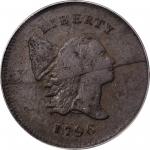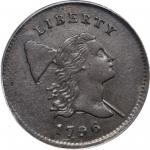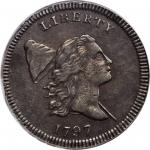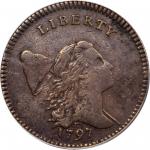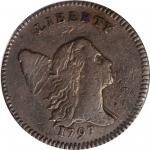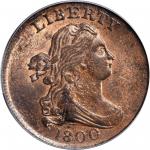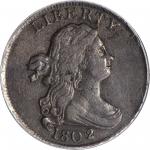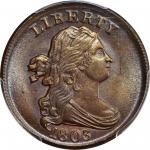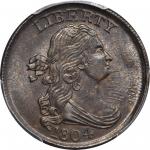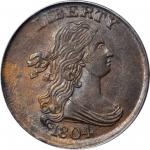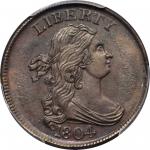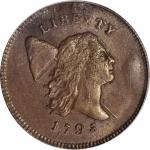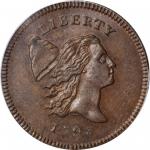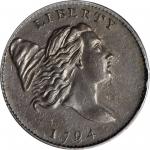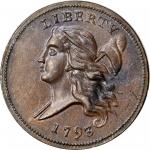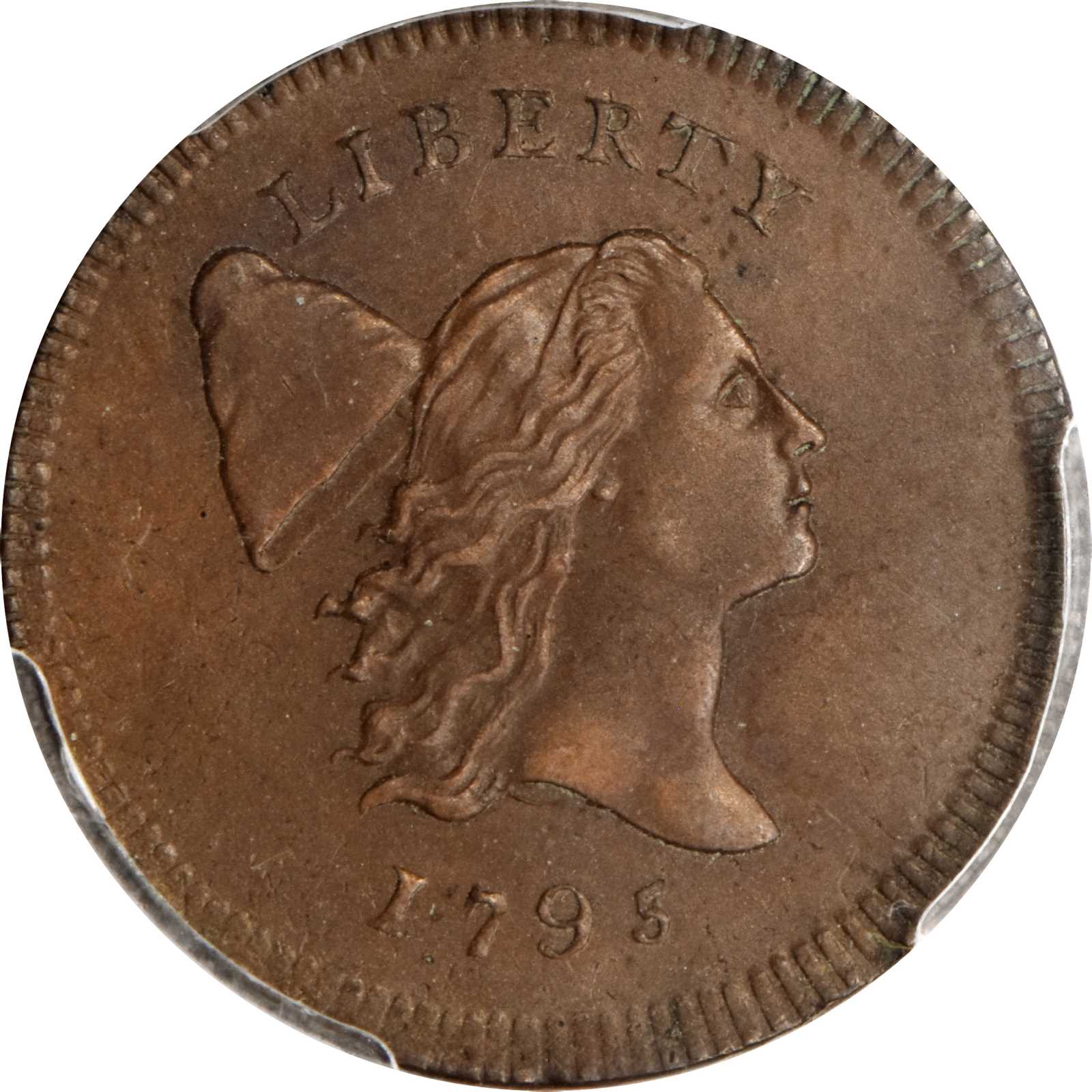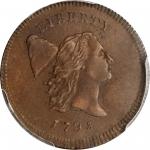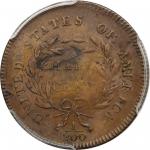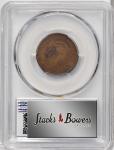1795 Liberty Cap Half Cent. C-5a. Rarity-3. Plain Edge, No Pole. Thin Planchet. AU-58 (PCGS). Type: Type III: Liberty Cap, Head Right, Small Head.Design: Obv: A head of Liberty with flowing hair faces right, a liberty cap and (usually) pole behind. The word LIBERTY is inscribed along the upper border and the date 1795 is below. The portrait on Liberty Cap half cents dated 1795 to 1797 is noticeably smaller than for the Head Right issue of 1794, and it constitutes a distinct type. Rev: A wreath surrounds the denomination HALF CENT, the legend UNITED STATES OF AMERICA around the border and another expression of the denomination, 1/200, below. A ribbon knot with double bow binds the base of the wreath. The device punches used for the dies of this issue are attributed to Assistant Engraver John Smith Gardner, and they represent a refinement of the basic Liberty Cap, Head Right design executed by Engraver Robert Scot the previous year.Weight Standard: The weight of the half cent was reduced from 104 grains (6.74 grams) to 84 grains (5.44 grams), on January 26, 1796, by presidential proclamation to conform with the Act of March 3, 1795. As all plain edge 1795-dated half cents were struck during calendar year 1796, they were nominally produced to the new weight standard. In practice, however, weights for 1795 Plain Edge coins vary widely, as evidenced by the fact that a survey of examples conducted by Manley (<em>Penny-Wise</em>, Vol. XXXI, No. 2, 1998) confirmed a range of 71 to 88 grains, with an average weight of 79 grains.Diameter: Approximately 23.5 mm.Die Variety: Cohen-5a, Breen-5a, Gilbert-6. Obv: From the 1795 C-1 variety produced earlier, the same device punch used for the letter I in LIBERTY was also used for the digit 1 in the date (I795). In this later state, the die was drastically reground, thereby removing the pole. This No Pole die state also appears in the C-5b and C-6a/6b attributions. Rev: Single leaf at the top of each branch in the wreath, three berries on the left branch, four on the right branch; there is no berry at either side of the bow. A die scratch extends diagonally left from the top of the letter C in CENT, although this feature can be difficult to discern on examples that are softly defined in the center of the reverse. The same die used for the C-4 and C-5b attributions.Along with C-5b, C-6a and C-6b, C-5a represents the Plain Edge, No Pole <em>Guide Book</em> variety of the 1795 half cent.Die State: Manley describes only a single die state for the 1795 C-5a variety. Obv: Reground and repolished with the pole removed, as above. Rev: The cracks from the Manley 2.0 die state of the 1795 C-4 die pairing are present, now more advanced. The prominent die break from the base of the first letter T in STATES to the leaf below is heavier and branches in the field near the leaf. The crack that originates from the base of the letter A in the same word is now much heavier from the wreath into the field above the letter F in HALF, with a tiny lump out of the die just below the uppermost leaf on the left side of the wreath. There is now a second heavy die break from the letter R in AMERICA, through the wreath, into the field above the letter L in HALF. This crack appears to join the aforementioned crack from the base of the letter A in STATES above the letter F in HALF, but close inspection with a loupe reveals that they are actually two separate breaks. More minor cracks are present from the border between the words UNITED and STATES to the berry above the letter H in HALF, and branching from the heavy break at the letter R in AMERICA to extend to the base of the letter C in the same word.Edge: Plain.Mintage: The <em>Guide Book</em> provides a mintage of 139,690 coins for all varieties of the 1795-dated issue. The varieties struck during calendar year 1796 (C-2b through C-6b) are thought to comprise the Mints deliveries from January 22 to June 8 of that year, with an estimated mintage of 114,090 coins. The actual total might be somewhat lower, however, if some or all of the coins delivered on April 19 (3,350 coins) and June 8 (1,740 coins) were dated 1796.Estimated Surviving Population for the Issue: 2,100 to 6,500 coins in all grades, for the entire 1795-dated issue. The estimate population for all four attributions of the Plain Edge, No Pole <em>Guide Book</em> variety is 900 to 2,850 coins in all grades.Estimated Surviving Population for the Die Variety: Rarity-3: 200 to 600 coins in all grades.Strike: With nearly complete border denticulation around both sides, this coin received an above average strike for a 1795 C-5a half cent. Most examples from this die pairing are devoid of denticulation from 7 to 9 oclock on the obverse and on the reverse outside the letter D in UNITED. On the present coin all denticles are evident, although those at 7 oclock on the obverse and 12 oclock on the reverse are a bit soft. The portrait, word LIBERTY and date on the obverse are all sharp with crisp delineation between most of Libertys hair strands. Most design elements on the reverse are also sharp, although the heavy break from the letter R in AMERICA has resulted in die swell that explains the softness to most letters in the denomination HALF CENT and the lower right portion of the wreath.Surfaces: This is a satiny and tight example with no detracting marks evident to the unaided eye. Warm golden-brown patina dominates the appearance, with a tinge of pale rose-red on the obverse. A few speckles of light carbon are scattered around the reverse periphery, the most prominent of which is outside the letter T in UNITED; a swirl of variegated color above the words HAL in HALF on the same side is also noted. Given the quality of strike and level of preservation, the eye appeal is strong, and certainly superior for this conditionally challenging early copper design type.Commentary: With upward of 2,850 coins extant, the Plain Edge, No Pole <em>Guide Book</em> variety of the 1795 half cent is readily obtainable for a product of the fledgling United States Mint. Most examples are attributed as C-6a, however, with C-5a considerably scarcer. The latter die pairing is also conditionally challenging with the vast majority of survivors in lower grades through VF, many also impaired. This near-Mint example is the finest that we have handled in at least 20 years, and we are pleased to be offering it for a second time since the turn of the 21st century.Cohen-5a is the thin planchet variant of the 1795 C-5 die pairing. The planchet stock is from rolled copper. From the ESM Collection. Earlier from our (Stacks) Franklinton Collection, Part II sale, January 2008, lot 18.

